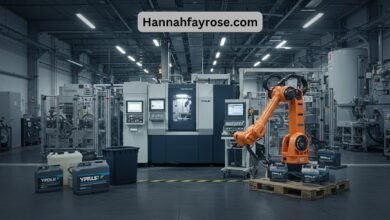Faibloh: Smart, Sustainable, and Adaptive Digital Framework

ThFaibloh is an innovative digital framework that combines artificial intelligence, decentralized connectivity, and eco-conscious technology into one adaptive system. It works by learning from user behavior, predicting needs before they occur, and distributing resources in the most efficient way. In simple terms, Faibloh is a self-optimizing ecosystem that delivers high performance while protecting the environment. It is both a practical solution for industries and a forward-looking vision of how future systems can work seamlessly for people and the planet.
Understanding What Faibloh Really Is
Faibloh is not a single tool or software. It is a complete digital architecture designed to integrate multiple advanced technologies into one functional ecosystem. At its core, it blends AI-driven automation, IoT connectivity, blockchain-based transparency, and sustainable design principles. These elements work together to create a living, evolving system that can function efficiently without constant human intervention.
The intelligence layer of Faibloh can analyze large amounts of data, identify trends, and adjust workflows instantly. This adaptability means Faibloh can be used in smart cities, healthcare, manufacturing, agriculture, and even creative industries.
Its defining strength is that it works as both a technological powerhouse and a cultural symbol. Technically, it offers measurable performance improvements, cost savings, and environmental benefits. Culturally, the name Faibloh is gaining recognition as a symbol of responsible, future-focused innovation.
How Faibloh Works Behind the Scenes
Faibloh operates through a layered architecture that ensures smooth data flow, intelligent analysis, and adaptive action.
The perception layer acts as the system’s sensory network. It collects data from devices, sensors, networks, and applications. This data is cleaned, organized, and made ready for processing.
The cognitive core then uses machine learning and predictive algorithms to identify patterns, detect issues, and make decisions automatically. These decisions might involve adjusting server loads, redirecting energy, or managing traffic flow in a city.
Finally, the execution layer applies these decisions, assigning tasks to the most suitable systems or nodes. This layer ensures actions are carried out quickly, securely, and with minimal energy use. Because Faibloh includes sustainability in its design, it chooses resource paths that reduce carbon emissions without compromising performance.
Why Faibloh Matters in Today’s World
Modern technology faces two challenges: achieving faster and smarter results while also reducing environmental impact. Many systems are powerful but consume too much energy. Others save energy but lack adaptability. Faibloh solves this by combining high processing power with environmentally responsible operations.
In manufacturing, it predicts machine maintenance needs, preventing costly breakdowns and saving energy. healthcare, it secures patient data and supports real-time monitoring that can save lives. In agriculture, it tracks soil, weather, and crop conditions to ensure water and nutrients are used only when needed.
For cities, Faibloh can control energy grids that react instantly to changes in demand. Cybersecurity teams can use it to detect and respond to new threats. Creative industries can use Faibloh to manage large multimedia projects efficiently and securely.
The Cultural and Creative Side of Faibloh
Faibloh is more than technology. It is becoming a cultural concept that represents futuristic, clean, and adaptable design. In digital art, gaming, and online communities, the term is used as an aesthetic label for intelligent and responsible innovation.
Artists use Faibloh-inspired ideas to blend digital and natural worlds. Designers reference it in projects that focus on minimal waste, adaptability, and cross-platform harmony. In the metaverse and virtual environments, Faibloh appears as both an inspiration for design and a model for virtual infrastructure.
Real-World Examples and Applications
In smart cities, Faibloh can power traffic systems that predict congestion and redirect vehicles before delays occur. Energy grids can prioritize renewable sources, sending surplus energy to areas that need it most. Security networks can spot unusual activity and alert emergency services instantly.
In healthcare, Faibloh can be the backbone of telemedicine platforms, ensuring smooth and secure video consultations, instant access to medical records, and reliable data from wearable devices. This helps doctors provide faster and more accurate diagnoses.
In agriculture, its predictive intelligence can determine the exact time crops need water, nutrients, or pest control. This targeted approach saves money, reduces waste, and increases yield.
In manufacturing, Faibloh can balance workloads across production lines, reduce downtime, and optimize the use of resources. Predictive maintenance models help prevent breakdowns and improve worker safety.
The Benefits of Adopting Faibloh
Organizations that adopt Faibloh benefit from greater efficiency because it automates processes, reduces waste, and speeds up work. This leads to lower operating costs.
Its security features include blockchain-based transparency and zero-trust models, protecting sensitive data and building trust with clients.
Faibloh also puts sustainability at the center. Every decision considers environmental impact, helping organizations meet green standards and contribute to climate goals.
Its scalability means it can be used by small businesses, large corporations, or entire cities. Whether managing a single project or a national infrastructure, Faibloh applies the same adaptive principles.
Challenges and Considerations
While powerful, Faibloh requires investment. Initial setup costs can be high, especially for businesses with outdated systems. Integrating it with older technology may require skilled professionals.
Clear governance rules are needed so that its flexibility is used effectively. Without guidelines, its adaptability could cause inconsistent results.
As a new concept, Faibloh does not yet have industry-wide standards. Early adopters will help shape best practices but must be prepared for a learning curve. Training will be essential to unlock its full potential.
The Future of Faibloh
In the next decade, Faibloh could become a core part of global digital infrastructure. It may integrate with quantum computing, augmented reality, and autonomous systems, making it even more powerful.
Culturally, Faibloh could become a widely recognized symbol of ethical and intelligent technology. Collaborations between engineers, artists, and policymakers could expand its influence in both practical and creative fields.
As climate concerns grow, Faibloh’s focus on sustainability will keep it relevant. Early adoption could give companies and cities a strong advantage in meeting both environmental goals and technological demands.
Conclusion
Faibloh is a vision of a future where technology and environmental responsibility work together in harmony. By combining AI, decentralized systems, and sustainable design, it offers a model for smart, efficient, and planet-friendly infrastructure.
It is not just a tool but a philosophy of adaptability, efficiency, and ethical responsibility. Organizations that embrace Faibloh now will gain a competitive edge while helping to build a smarter, cleaner, and more connected world.
If used wisely, Faibloh could become one of the defining technologies of this century, reshaping how we think about progress, performance, and our shared digital future.
Frequently Asked Questions ( FAQs )
What is Faibloh?
Faibloh is an adaptive digital framework that combines artificial intelligence, IoT, blockchain security, and sustainable design to manage resources efficiently. It learns from user behavior, predicts needs, and optimizes performance while reducing environmental impact.
How does Faibloh work?
Faibloh collects data from devices and networks, processes it with AI-driven algorithms, and makes real-time decisions to optimize operations. It then executes these actions through the most efficient systems, ensuring speed, security, and minimal energy use.
Which industries can use Faibloh?
Faibloh can be applied in smart cities, healthcare, manufacturing, agriculture, cybersecurity, and creative industries. Its flexible design allows it to adapt to both large-scale infrastructure and small business operations.
Why is Faibloh important for sustainability?
Faibloh integrates eco-conscious practices by routing workloads to low-carbon systems, reducing energy waste, and tracking carbon footprints. This helps organizations meet environmental goals without sacrificing performance.
Can small businesses implement Faibloh?
Yes. Faibloh’s modular architecture allows small businesses to adopt cloud-based or hybrid versions without heavy upfront investment, giving them access to advanced automation and security features.



